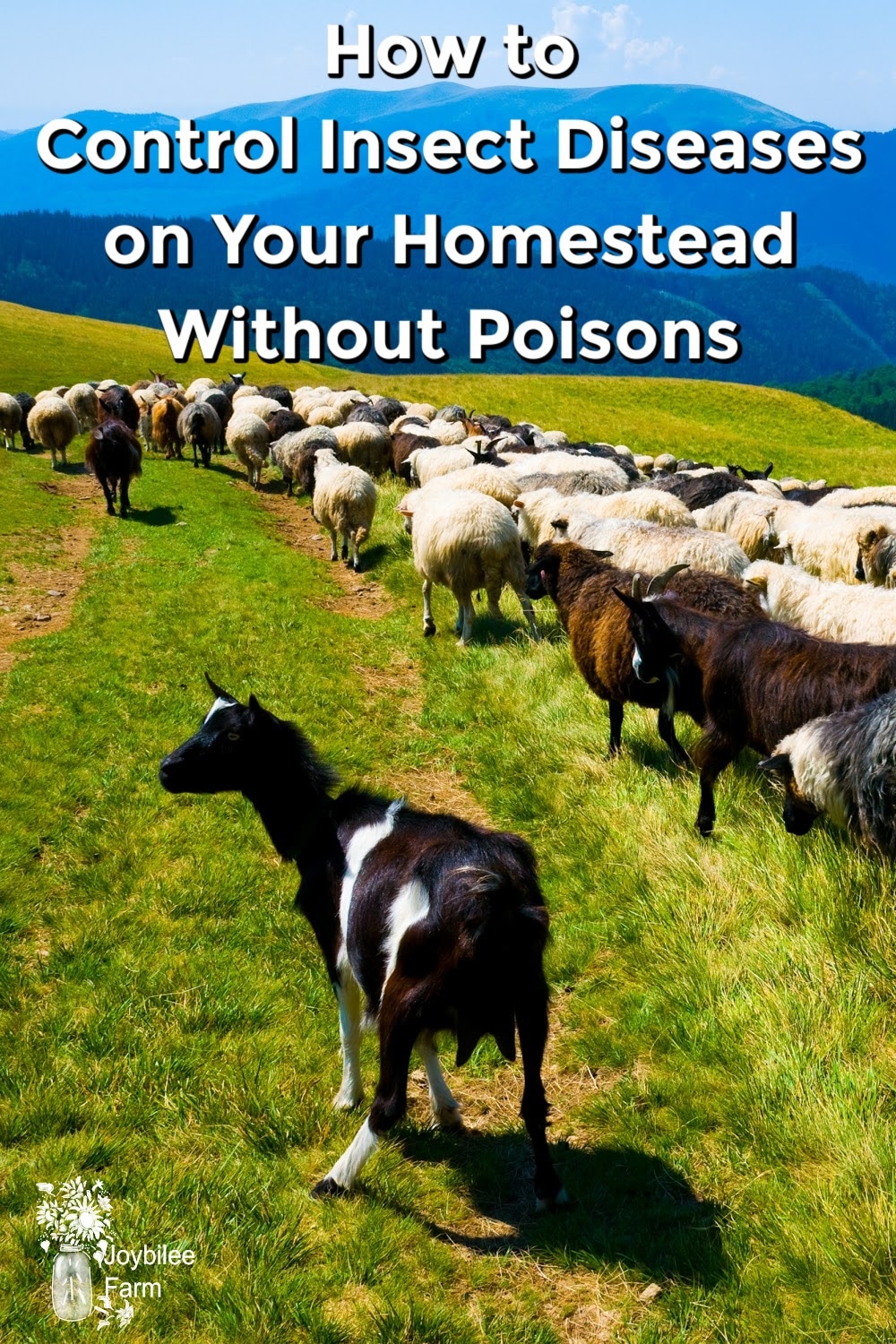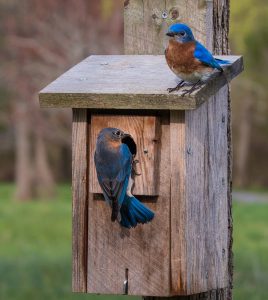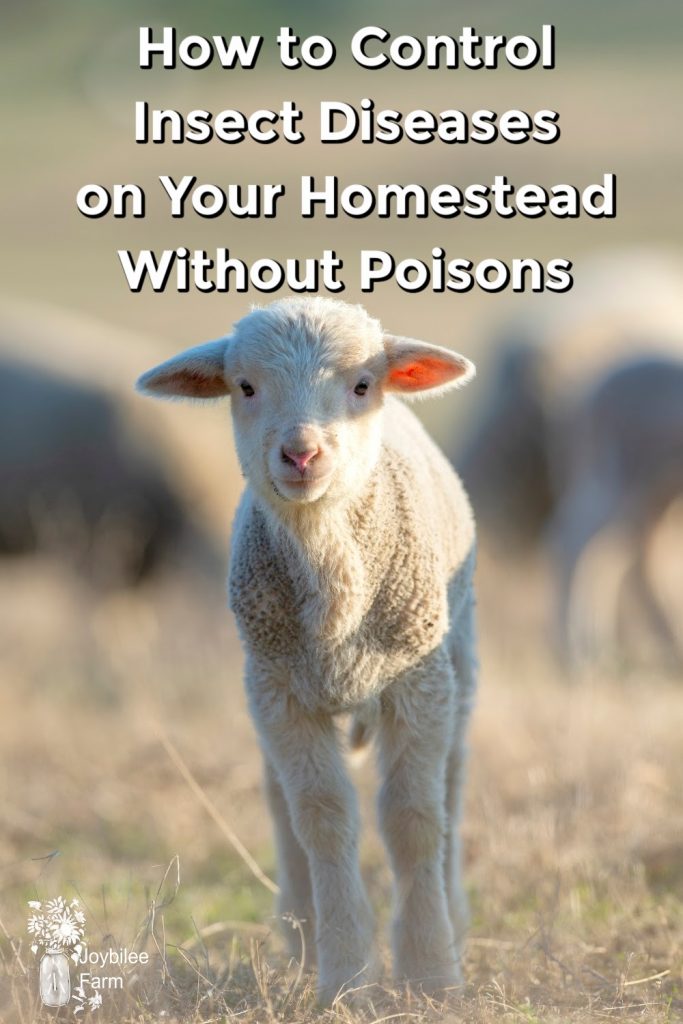How to Control Insect Diseases on Your Homestead Without Poisons
Learn how to use natural ways to control insects and prevent insect diseases in your livestock without using harmful chemicals.

This is part 2 of a series of posts on Controlling Insects to reduce disease on your homestead.
Part 1: Dealing with parasites in your goats and sheep.
Part 3: Herbal Medicine to Control Insects and Prevent Diseases in Your Livestock
Insects are the vectors of disease on your homestead. A bite can be a simple irritation to your livestock, or it can transmit deadly disease through your entire herd or even to your family. Further, the spectre of terrorism, civil unrest, and war increase the likelihood that you will need to know natural ways to prevent insects from overrunning your homestead.
I’m in the middle of reading the Kindle version of “6 legged soldiers: Using insects as weapons of war”. It’s on special this month for $1.99. Every homesteader and prepper should read this book and be prepared to deal with an onslaught of biological warfare using insects as the vectors of disease. (Check the price before you click — it may not still be on sale, by the time you read this.)
Six-Legged Soldiers: Using Insects as Weapons of War
I learned from the very well-written book, that when engaged in biological warfare or terrorism, bacteria do not fare well away from a host vector. But add a louse, a flea, a mosquito, or a fly and epidemics can be ignited, with the deadly disease spreading throughout the countryside. More people are killed by disease, spread by insects, during the war, than are killed in action and this is true throughout history. Today, however, governments have gained the ability to multiply the use of insects for war and terrorism, at an unprecedented rate.
After the armistice, at the end of WWII, Japan released rats, infested with fleas, carrying bubonic plague (Black Death) throughout the countryside in Manchuria, China. There were more peasants killed from the resulting plague, which lasted many years beyond the war than were killed by the A-Bomb. At the time only Japan had the technology to use insects as a wartime arsenal, but now every nation in the world and every terrorist group has this knowledge.
DDT was initially developed to control lice on POWs and civilians during WWII, to prevent disease in crowded conditions. DDT is not available today, because of its toxicological effects on the environment. Other insecticides work temporarily until the insect develops immunity. This is happening more frequently with the sheer amount of pesticides being poured on cropland around the world. Your best defence is herbal preparations that you can make at home, combined with traps to remove excess insects from your barn loafing areas, patios and home.
So the best way to protect your family and your homestead from attacks, or just from nuisance insects is to use herbal sprays, keep the areas clean of food scraps and hiding places, use specific traps, and have supportive therapies in case of bites, and infestation, that is strongly antibiotic, antiseptic, and healing. Antibiotics are used to help fight many of these diseases.
Human Pestilence carried by insects:
Black Plague is carried by fleas that feed on the blood of infected rats, which then bite humans and livestock. The disease is a bacteria that works quickly and systemically. Death can take place within 48 hours and up to two weeks. During WWII, 8 out of every 10 people infected died of the disease. An especially virulent strain was used as a weapon by Japan against Russia, and China. About 1,000 to 3,000 cases of the plague are reported annually. An infected person can pass the disease to another person. In the US there are reports of incidences of the plague in New Mexico, Arizona, Colorado, California, Oregon, and Nevada.
The fleas feed on wild rodents, such as the rock squirrel in the Southwest and the California ground squirrel in the Pacific states. Prairie dogs, wood rats, chipmunks and, less commonly, rabbits have also been known to carry infected fleas.
Cats and, less often, dogs can transmit the plague to humans as well — by carrying fleas into the house or by contracting the plague themselves (through flea bites or by eating plague-infested rodents) and then biting or scratching humans. Very rarely, a cat can develop plague pneumonia and spread the disease by coughing.
Yellow Fever, Malaria, Dengue, West Nile Virus, and Hemorrhagic Fever are pestilences that are carried by mosquitoes, which bite an infected mammal and then bite a human. Controlling mosquitoes will go a long way to controlling an outbreak of any of these diseases. While in Canada we think of these diseases as being tropical diseases, however, with the prevalence of global travel, our Northern populations can be exposed to these diseases, too. Malaria was introduced into Canada in the 16th and 17th centuries by immigrants from tropical areas, British soldiers coming from India, Black slaves from Africa, and ships carrying goods from the Caribbean. Malaria is controlled where the breeding grounds for mosquitoes are drained or treated. We’ll talk about that later.
Flies are the vectors for typhoid fever, an illness passed from infected feces to water supplies. People contract typhoid by contact with infected water. Flies can accelerate the spread of the disease. Cleanliness and clean water are the first defence against typhoid. But when infrastructure breaks down and water supplies become contaminated, as in the aftermath of the Earthquakes in Haiti, in 2010, or during civil unrest or war, typhoid can infect large populations. Soap and water hygiene, water purification, and control of flies prevent the disease.
Typhus Fever is not passed from person to person. During the Napoleonic wars, Napoleon lost more soldiers to typhus than to the battlefield. Also called “trench fever, the vector is a body louse. In unclean conditions, the louse can hide and reproduce. Humans are infected through the blood-sucking louse. DDT was invented to kill lice in Europe during WWII and incidences of typhus are rare today. There are only about 100 cases of typhus reported in the US each year.
Ticks spread Lyme disease, Spotted fever, Hemorrhagic Fever, Tularemia, and paralysis. There are several ticks in North America and all can be carriers of the disease. By checking both animals and humans regularly during tick season in Spring to Early Summer, and removing ticks before they embed, these diseases can be prevented.
Many of these pestilences are mostly seen in rural areas where humans interact with livestock, pets, and nature. While the huge devastation from the plague happened in towns, now hygiene and city infrastructure prevents most diseases from taking hold. As long as the infrastructure holds cities will remain relatively free of plague and pestilence. How can the homesteader prevent these vector diseases from visiting his homestead?
Controlling Flies around barns, and loafing areas to prevent insect diseases
Flies spread disease by breeding in waste, manure, compost piles, blood spills, and outhouses. Once they touch down on rotting flesh or manure, they lift off again and land in water supplies or feed. The hair on their legs carries bacteria and disease, which are then ingested by animals. Some flies also bite you and your animals, transferring the diseases that they carry through the blood. Further, blowflies and nasal bot flies torment your animals by laying their eggs on wounds, or in the nasal cavity and their maggots eat the flesh of their host. Something you want to avoid. The life cycle of a fly is approx 10 days to 2 weeks. Each female adult fly lives approx. 143 hours and in the time lay thousands of eggs. This cycle repeats numerous times in warm weather.
Using livestock to control flies
The best way to control flies is to prevent them from reproducing. Free-range poultry is one of the first defences against infestations of flies, as well as other insect pests. They scratch or puddle into the manure pack in the barnyard and will feed on maggots, the larvae stage of the fly. Ducks are especially fond of insects, and experts at finding and consuming large numbers, at every stage of their life-cycle. I have watched duckling just 24 hours old, searching for flies to eat. They also relish slugs and snails. Chickens, too, are good at finding and consuming maggots, although they don’t go after flying insects as voraciously as ducks…
Using traps
Every barn should be equipped with fly traps in several key areas, beside windows, and near lights that will attract the pests. There are several patterns for homemade fly traps available, they work on the principle that while flies will enter a trap by flying upward through a small opening, to enter the trap. They don’t fly downward as easily and become trapped. These traps should be cleaned or replaced at least once a week so that any eggs laid within the trap are not given a chance to move to the adult stage. You can download this sophisticated trap from TALC, made with 3 upcycled plastic 2-litre bottles.
Avoid using sticky traps within barns. They expose your animals to adult flies, which are very much alive when they are attached to the fly strip. Animals can also become entangled in the strips. A well-maintained trap can remove up to 30% of the flies from your livestock enclosures. By setting them up early in the Spring, you will greatly diminish the fly population.
Making animals inhospitable hosts help control insect diseases
Animals become hosts to flies when there are open wounds, and when they are soiled with manure. Keeping your animals clean and their wounds clean and sprayed with antiseptic will prevent fly infestation. Any caged animals or confined animals should have manure piles kept clean daily at best, or at the very least once a week. An adult blowfly lays 250 eggs per site. Fly maggots hatch within 23 hours and begin feeding on the flesh of the animal, so an animal with a soiled butt can be infested with blowfly maggots in one day. Keep them clean. Baby butts can get caked with manure and so keeping them washed and dry will help. If you see diarrhea in a kid or lamb deal with it. Don’t wait. This is the reason that shepherds in the West dock their lamb’s tails. But even tail docking won’t prevent 100% of blowfly infestations. They can kill a young animal.
If you wash a baby’s butt and find maggots you have an emergency. The baby animal can die from shock. Clean the area with soapy water, and using a syringe (without a needle) irrigate the wound with hydrogen peroxide. The bubbling action will force the maggots to the surface where they can be washed away. Clean away any soiled hair or wool. Gently scrape the wound and continue to syringe until there are no maggots left. Spray the wound with tea tree oil to disinfect and to make it inhospitable to further infestation. Keep the baby dry and clean and support its care with warmth and proper nutrition and water, until it is healed up. Check weekly for further infestations.
Herbal repellents
Many herbs will make the animal unappealing to flies. Strong smelling herbs like garlic, mint, wormwood and tea tree disguise the smell of urine and manure and make the host inhospitable. These herbs can be macerated in witch-hazel in your blender and sprayed along the top line of your sheep or goats.
Joybilee Farm Herbal Insect Repellent for Livestock
Use either fresh or dry herbs or a combination.
Put 2 cups of witch hazel in your blender
Add 1 handful of mint leaves, lemon peels, and wormwood
Add cloves from one head of garlic
2 tsp. of tea tree e.o, 1 tsp lemon verbena e.o., or lemon e.o., 1 tsp. lavender e.o., 1 tsp. cedarwood e.o., 1 tsp. eucalyptus essential oil, 1/2 tsp. rose geranium oil (omit tea tree if using on rabbits, cats, or dogs).
Blend it all, well until it is liquefied. Strain mixture. Use 1 cup of mixture with 2 cups of water in a spritz bottle and spray the top line of your sheep and goats. The top line is the area from the back of the neck along the backbone to the tail head. Avoid the head area, as the pungent herbs can make your animals’ eyes water. This mixture will repel flies, mosquitoes, fleas, ticks, and louse, with some adjustments.
Controlling mosquitoes around the homestead to prevent insect diseases
Each year 500 million people are infected with mosquito-borne illnesses and 2.5 million of them die. Those who do not, often have recurrences of debilitating disease whenever their immune system is weakened. Mosquitoes are a serious pest and your war on the mosquitoes in your environment should vigorous.
Encouraging predator control of mosquitoes
Swallows, bluebirds, warblers, and bats are strong predators of mosquitoes. My friend, Connie, uses goldfish in her livestock watering tank to take care of larvae, too. Ducks and geese will also eat the larvae stage of mosquitoes if given access to standing water. Dragonflies, frogs, and toads also feed on mosquitoes. Encourage their life cycles by providing a fully hospitable garden with nectar-producing flowers, woods, herbal lea and brush.
Cleaning up breeding areas
Mosquitoes breed in stagnant water, water buckets, marshy areas, and flood plains. Water pails should be kept clean and empty. Standing water in old tires, bathtubs, sinks, gutters, and planting pots should be drained and kept under cover so that they cannot fill with rainwater. Rain barrels should be covered to keep mosquitoes out. Where standing water cannot be drained, peppermint essential oil in a carrier oil can be applied to stagnant pools and ditches. The larvae need to surface to breathe and rely on surface tension. Adding peppermint oil to the surface of standing water smothers the mosquito larvae. A study done in New Delhi reported 90% of larvae die when coating the surface of standing water with 3 mm of peppermint oil. Depending on your situation this might be a viable option. Peppermint oil is a very inexpensive essential oil and is worth considering if your situation demands an organic, and effective solution to mosquitoes.
Herbal repellents to help control insects and prevent diseases
While citronella is a common essential oil to add to herbal mosquito repellent, its effects are short-lived, so that the spray has to be reapplied frequently. Peppermint essential oil is specific to both flies and mosquitoes and has a longer life on the skin. However, the sensation is cooling, and so rather than using straight peppermint oil, other oils are added, such as tea tree oil, lemon oil, rose geranium oil, lavender oil, and eucalyptus. A combination of oils is long-lasting on the skin and the synergistic effects are more powerful than chemical repellents. I mix up a blend of olive oil, with 4 drops each of tea tree, peppermint, eucalyptus, cedarwood oil, and lemon verbena and spritz doorways to keep mosquitoes outside. I spray this in doorways and on people and pets (omit tea tree if you are using this on cats or rabbits).
Plant herbs with repellent effects
Lemon verbena, lemon thyme, peppermint, and lemon balm all repel mosquitoes. Plant them around patios, and play areas. Lemon thyme varieties are especially effective, as they can be stepped on and will release their pungent, lemony scent regularly.
Using Bug Lights to Help Control Insects and Insect Diseases
Bug lights will patrol your patio and barnyards 24 x 7. While the effectiveness rating states a certain radius from the light — 1/2 acre, 1 acre, and 1 1/2 acres — I find that the protected zones are overstated, so invest in larger light and expect it to cover a smaller area. We place a hardware cloth screen over our light to keep moths, butterflies, and dragonflies from being zapped along with flies and mosquitoes. The lights are baited with a pheromone that attracts mosquitoes. Without the pheromone, the mosquitoes are not attracted to the light. You can make your own by using yeast, sugar, and water to produce carbon dioxide. The pheromone needs to be replaced in these lights about every 30 days during your active mosquito season. Don’t expect the light to be effective if you have not taken steps to reduce mosquito breeding areas. This is the light we use, with the addition of a handmade screen to keep larger insects away from danger. The lights are powered with an electrical cord or you can get a propane model for remote areas. They are about 75% effective.
Flowtron BK-40D Electronic Insect Killer, 1 Acre Coverage
In the next installment of this series on homestead medicine I will talk about controlling lice, and ticks on your livestock, without chemical poisons. Be sure to subscribe to my RSS feed using the box at the right, or the RSS icon at the top right. I will also be adding more article links on my Facebook page, as I research these issues over the next few weeks. Become a fan so you don’t miss any of the pertinent links.







During the summer mohtns, flies and mosquitoes are abundant, but, when winter arrives, they seem to disappear magically until the temperature warms up again But why? And where do they go?Some of these insects hibernate through the cold winter mohtns in dark and damp places, such as in logs or under houses When the weather warms, the females become active, feed and lay eggs Similarly, some flies are programmed to become dormant before the cold weather sets in—i e , they diapause The rise in temperature breaks the dormancy.Other insects simply don’t survive the cold weather and die These insects lay their eggs in summer and, when the winter arrives, the adults die and the eggs freeze In spring and summer, the eggs thaw and hatch to produce the next generation.Some bush flies die out completely in the colder areas but thrive in warmer climates, and in the summer they are blown from the warmer areas to repopulate the colder areas, where they breed again.Some other species of insects, such as the monarch butterfly and certain crop pests, migrate to warmer areas during the cold mohtns, only to return when the temperature increases. +5Was this answer helpful?
Most mosquitoes spend the winter months as eggs, lying dormant in wait of spring snow-melt and rain to activate them. Some will hide in the leaf litter on the forest floor, protected from the worst cold by the insulating snow until they thaw in spring. Others will hide in deep burrows or caves, hibernating until spring. Several species that do this have found that our modern storm sewer systems are ideal places to spend the winter. The mosquitoes that are the primary carriers of West Nile virus are among the species that do this. In some areas, the walls of storm sewer outlets can be covered with hibernating female mosquitoes.